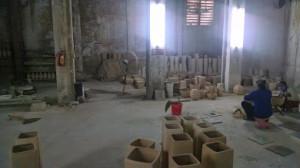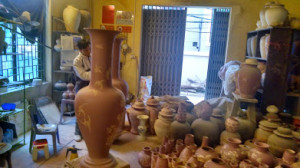Going into the trip to Vietnam, everyone I talked to raved about Hoi An and spoke so highly of the tailors who work there. I thought tailors was a random thing for a city to be known for and assumed there would be a few tailor shops here and there. As we went on our bike ride through town, looking down the street, every other shop was either a tailor or a leather shoe store. I was intrigued and went into Bebe tailor shop with a few of the other girls on the trip. I was immediately overwhelmed, the sales women surrounded us. They were throwing iPads, catalogues, and fabric swatches at us and pulling out sketchbooks to draw up designs. It was all too much for me to handle so I went back to the hotel, found pictures of the dresses I wanted and returned the next morning.
My salesperson was named Lien. She drew up my designs, helped me choose fabrics, and took all my measurements. As this was happening, the manager of the store came up and was talking with us. He was ecstatic about our huge group that was ordering everything from dresses, to suits, and shirts. We managed to work out a deal with him, 2 dresses for $100 which when he agreed threw the sales women into a frenzy. He later explained to us that they work off commission which is why they were upset. I assumed they still made okay money though based on how busy the shop and the tailoring industry was and didn’t think much of it.
Three days and four fittings later I had three new friends: Lien, Lina, and Yen. Over the numerous trips to Bebe I had learned more than I ever expected about these women from their jobs to the families. Working at Bebe they made 4 million dong a month (approximately 188 USD). They worked from 8 am to 10 pm most days and only got two days off every month. I later did the math and found out they were only making about $7 a day; and they aren’t even the ones working in the back making the clothing. I imagine that the seamstresses make even less, but none of the women knew. Lina wore a blazer over her Ao Dai uniform everyday and it had been made at the tailor; when I asked if she got a discount she simply laughed and shook her head no.
These women worked so hard and attended to our every need with a smile. As I learned more I realized how vital we are to their livelihood, without our business they would be making even less monthly and I felt guilty for bargaining the price down so low. My dress was finally finished and as I checked out, I gave Lien a $5 tip as I hugged her goodbye. She jumped for joy and hugged and thanked me. The women around who saw were all making a commotion and hugging her and congratulating her. I never expected such a response and realized that while $5 to me was nothing more than a Starbucks coffee, to her it meant so much. The amount of work these women do for so little shocks me and makes me grateful for the $8 minimum wage in America. I wish them all the best and hope one day they make the money they deserve for all the hard work they do and talent they have.

 Follow
Follow




